THE INTRIGUE OF LOURMARIN’S DOMAINE DE LA CAVALIÈRE AND ITS NATURAL WINE
by Susan Manfull
In August, the tiny villages of Provence swell with visitors from around the world. In Lourmarin, the charming Luberon village where luminaries like Henri Bosco, Albert Camus, and Peter Mayle once lived, one is likely to hear smatterings of several foreign languages while strolling through the Friday market. At Café Gaby – if you are lucky enough to find a table on market day – you might hear German, Dutch, Chinese, Russian, and various forms of English, all while enjoying lunch. I have.
It was amidst a cacophony of local voices at the café this past August, shortly after we arrived, that I began to hear about a very talented winemaker who was making vin naturel in the village. I thought I knew all the wineries in the area, even stretching the definition of winery to include the farmer who sells his rosé alongside his melons, alerting passersby that he is open for business by setting out a barely legible, hand-written sign at the end of his driveway. I had written about almost all these wineries.
Right around the same time, Towny brought home a newly released bottle of locally produced red wine, a natural wine, that our friend, Hervé Giustiniani, said I had to try. Giustiniani owns De la Cuisine au 20, a small shop filled with high-end culinary tools, gourmet food products, and wine and spirits, located in the heart of Lourmarin. He has his finger on the pulse of the village. Echoing the sentiments I had heard at the café, he said the winemaker was new and exceptionally talented. We planned our dinner around it.
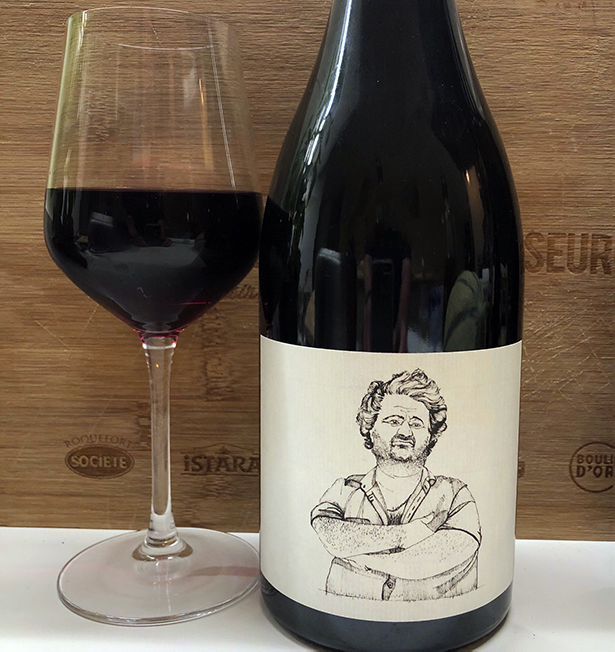
Our first bottle of “After Tracteur” that brought our attention to Domaine de la Cavalière. Photo by Susan Manfull
The bottle is heavy; the punt is deep. The label is a pen and ink drawing of a burly man with thick hair and brows and a pleasant, unshaven face. His large arms are loosely folded across his chest. He looks gentle, pensive, humble…or is he just tired? Who is this man? Is it Julien Besson, the winemaker at Domaine de la Cavalière?
The back-label reads “Julien de la Cavalière.” Maybe it is Julien. The cuvée is named “After Tracteur” 2018 and the cépage is 100% Grenache noir. The label also reveals that this heavy bottle with the deep punt is a Vin de France. A single varietal wine cannot claim Appellation d’Origine Protégée (AOP) status in the Luberon appellation, but why not Indication Géographique Protégée (IGP)? Domaine de la Cavalière intrigued me from the beginning.
Here are my notes about our inaugural tasting of “After Tracteur” from Domaine de la Cavalière, as posted on Instagram on August 28, 2019:
I am so over the moon about this vin naturel Grenache that I went right back the same day to @delacuisineau20_lourmarin to buy more!
C’est incroyable! Rich and earthy with almost surprising freshness in a medium, well-structured, and nicely balanced body. Per guidance from wine shop proprietor, Hervé, we decanted the wine for nearly two hours and, still, it seemed to evolve in our glasses!
We happened to pair it with a fresh tomato sauce over pasta (not a match made in heaven), and we still loved this wine!
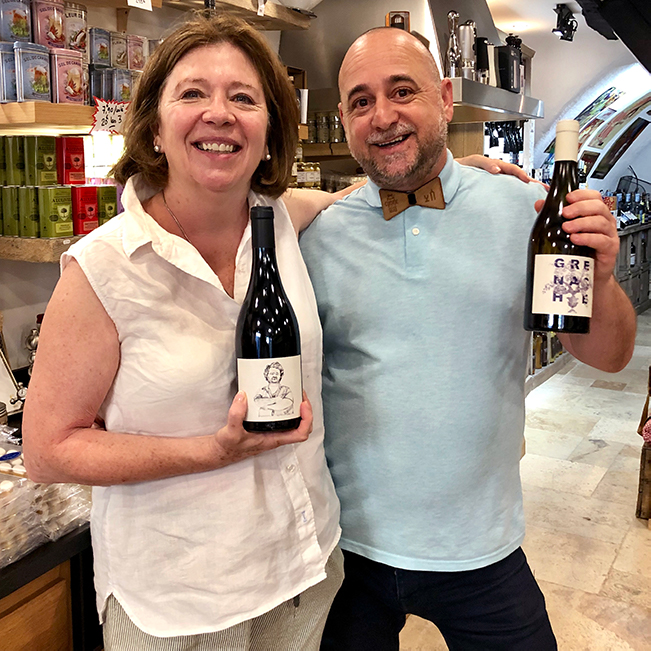
Susan Manfull and Hervé Giustiniani share their appreciation for Julien Besson’s wines in the middle of Giustiniani’s store, De la Cuisine au 20, the only retail outlet in France for Domaine de la Cavalière wine.
It wasn’t long before I tried the 2018 rosé “Le Bouquet” and the 2018 single varietal Grenache blanc “G.B.,” both of which were made, like all Besson’s wines, from hand-picked organic grapes with native yeast, minimal intervention, very light filtration (of the rosé and the whites) and a tiny amount of sulfur added just before bottling. Although his portfolio may vary from vintage to vintage, it is currently weighted in favor of reds but, I would soon learn that Besson strongly believes that the terroir of the Luberon is more conducive to growing white grapes.
In February of 2020, my husband Towny and I were able to visit Domaine de la Cavalière.
Domaine de la Cavalière – The beginning
The domaine is located on the north side of Lourmarin at the end of the narrow Chemin de la Combe des Cavalières at the base of the Grand Luberon. Just past the property, unpaved fire roads traverse the thick forest. With a name like “cavalière,” which translates to “horsewoman” in English, it is not surprising to find the property well into the countryside.
“Enchanting” is the first word that came to mind as the iron gate slowly swung open and we follow the long driveway inside to park. We gleaned hints of a graceful beauty, confirmed as we continue walking. Stone walls, an undulating green lawn dotted with trees planted long ago, a splash of color from cherry blossoms, perfectly manicured shrubs, rows of trimmed mounds of lavender, a large potager enclosed by stone walls, garden ornaments here and there including a small statue of a life-like dog, strategically placed benches of every variety imaginable, vine-covered arches of limestone, fountains not yet flowing, stone staircases — some leading up, others down, destinations not known yet—and the barest outline of an expansive home with understated elegance tucked into the landscape. Dogs dart in and out of view. The sounds of farm animals can be heard in the background.
The Luberon Massif form the backdrop and somewhere in between are olive groves and vineyards. The property is immense, but it instills a welcome intimacy. It is stunning in its beauty, certainly, but it is a magical feeling that dominates the senses.
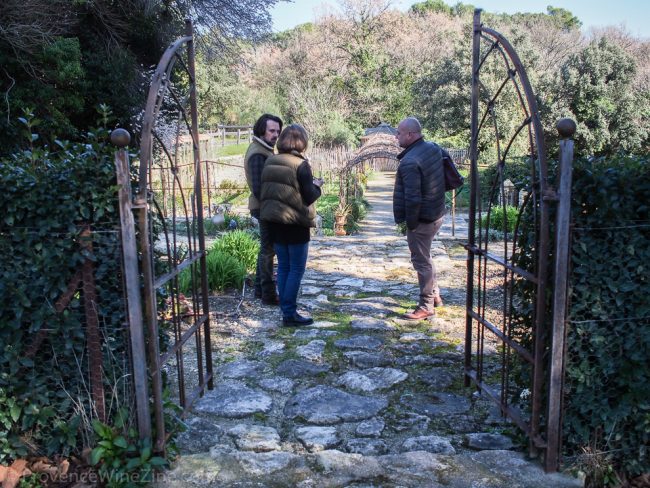
Entrance to le potager. Pictured from left to right: Julien Besson, Susan Manfull, and Hervé Giustiniani. Photo by W.T. Manfull
Hervé Giustiniani is there and introduces us to Julien Besson. He is handsome with a twinkle in his eye and a beguiling smile that belies his 37 years. His English comes with a pleasing French lilt and, as he begins to tell us about the domaine, his passion is palpable and contagious. If this were a film, I would have cast him to play the estate manager, private chef, winemaker, and olive oil producer that he in fact is.
Besson agreed with my impression that Domaine de la Cavalière feels magical. “There is something special, something different. Like something mysterious,” Besson said, adding “There is no address and people don’t know where it is. It is a secret place.” But he said that someday he envisions people coming to the gate to buy organic fruits and vegetables, herbs, and flowers and that they, too, will be as captivated.
The domaine comprises about 45 hectares, almost half of which are covered by forest. The vines and olive trees each cover about eight hectares and the horses, donkeys, and goats have about four hectares on which to roam. On the rest of the property lies the home and various amenities such as the pool and pétanque and tennis courts, the cellar, beehives, the potager, and the barnyard area where the two pigs and a few hens and roosters live free of any worry that they may end up on someone’s plate.
The owners of the property are an American couple, Jeffrey and Laurie Ubben, who, according to Besson, fell in love with the Luberon while on vacation. Jeffrey Ubben is the founder of ValueAct Capital, a San Francisco-based investment company where he served, until recently, as the Chief Executive Officer and Chief Investment Officer of the company. In addition, he apparently also has a vested interest in DuMOL, a small producer of high-end, carefully crafted wines made from grapes grown in reasoned sustainably farmed vineyards in and around Russian River Valley in Sonoma County, California. The Ubbens are highly regarded for their generous philanthropy.
Besson first got to know the Ubbens when he worked as a private chef for them during one of their vacations in Provence. At the time, Besson was living in Paris but, apparently, they hit it off so when Besson returned to the south while on vacation from his restaurant work, he would cook for the Ubbens.
Besson chuckles as he tells the story about how he came to work for them full time at Domaine de la Cavalière in Lourmarin. About five years ago, when the Ubbens purchased the Lourmarin property, they asked Besson if he would come to work for them “on the farm,” as they put it.
“A farm?!” Besson said. “And, in my mind, I say ‘oh God, no, maybe goat cheese, a cow’… I don’t know what’s happening,” Besson continues. “It’s not my work.” But, when he saw the photos, he realized that it was a mas, the Provençal word for a traditional farmhouse that, nowadays, is commonly converted into a luxury home. The vines, the olive trees, the potential…. Julien enthusiastically accepted the offer.
“When they bought the house, I had two choices in my mind,” Besson reflected. “…to do something with everything or to do nothing and take vacation all the year.” Besson continued, “I could come here and stay, relax, sell the grapes to the co-op, sell the olives to the co-op and do nothing.”
“But I said, that is not my job…. that is not my life. I want to create…I want to make something special for nature and for my life, for my child, for my wife,” Besson explained. “I want to make something special in the end…maybe I can touch some different people and connect some people with this domaine.”
A Chef in the Garden of Cavalière
“My dream, as a cook, was to make my own olive oil, my marmalade, compote, jams, and [to have] honey,” Besson said. “Sometimes, I feel like I am in a dream.”
But, the 900 olive trees are not a dream. From those, Besson now makes two stunning olive oils, both organic and unfiltered: Fruité Vert, a full-bodied and very flavorful olive oil with a little kick at the end, and Fruité Noir, made from partially fermented olives that is reminiscent of a rich tapenade.
Besson did not grow up in a family of chefs but he was raised by parents who deeply respected nature and appreciated the seasonality of dishes. He grew up in Nice where, he said, it was a pleasure to regularly venture into nearby forests with his family. “When I was young, my parents would take me into the forest to find mushrooms. I remember bringing home sanguins and cepes! And, in the spring, asparagus!”
Now, Besson can step out his kitchen door and snip, pick, or dig up much of what he needs when he cooks. One of his first projects upon arrival was to create a potager. This particular “kitchen garden” was unlike any I have seen. Yes, there are the requisite organic vegetables, herbs, fruits, and flowers, all strategically and artistically intermingled with companion plants in beds, thus living up to the definition of a potager; but there is so much more to behold.
Gorgeous stone walls surround the potager, sheltering it from the natural elements and wildlife, but also providing a beautiful backdrop. An informal, natural style (much like an English garden) dominates the picture although the arrangement of the beds and the long pergola denote a formal structure and there are more formal characteristics along the perimeter. Every sense is titillated from the wafting scents of verbena to the delicate tastes of citrus caviar. The design, both as a whole and in the details, is breathtaking.
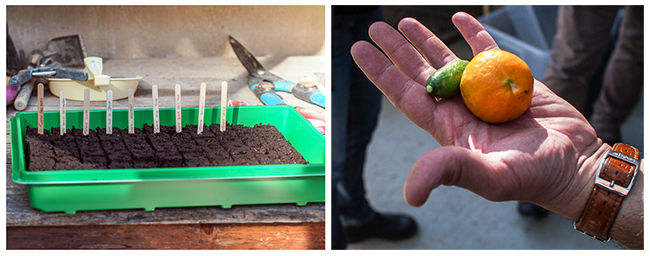
Heirloom tomatoes germinating (left) and citrus caviar with an heirloom Mandarin orange (right). Photo by W.T. Manfull
Although we did not have the pleasure of seeing the flowers in bloom, Besson assured us that they are there in abundance because, among many reasons, his fiancée, Charlotte, is a florist.
This kitchen garden is clearly designed for the cook who can decide the dinner menu as he or she wanders among the cuisine-complimentary plants. But, keeping an eye on the future was also a guiding principle. The emphasis on heirloom vegetable varieties reflects this principle and is exemplified in the inclusion of over 20 varieties of tomatoes, some of which the French government has mandated to be preserved. The wholehearted adoption of a permaculture philosophy demonstrates a serious commitment to the future. A permaculture specialist, Jonathan Gallois, was just brought in to take responsibility for the potager.
Being a strict pot-gardener myself, I had to look up “permaculture” and what I learned made my head spin. Far too much to put forth here so suffice to say that, broadly speaking, permaculture is both a philosophy and a practice of agriculture that views the whole ecological system being composed of interdependent parts. The focus is on creating a “perennial and sustainable” approach to agriculture that is mutually beneficial for the environment and humanity. It is a long-term investment that requires observation, feedback, creativity, and patience.
Very broadly speaking, the following two questions, posed by Bill Mollison, the Australian biologist who, with colleague David Holmgren, is credited with co-developing the idea and practice of permaculture, sum up this approach:
“What can I get from this land, or person?” or “What does this person, or land, have to give if I co-operate with them?” Of these two approaches the former leads to war and waste, the latter to peace and plenty.
This philosophy is echoed in much of what Besson is doing on the property: his inclusiveness of others; his self-regulation as seen in his not taking on more than he and his team can do well; his understanding that it is best to focus on what he and his team can control and not expand beyond that; his emphasis on local talent; his reliance on observation; his patience; and his recognition of happiness as being an important part of the equation of success.
It is certainly reflected in his winemaking.
Re-creating Domaine de la Cavalière Vineyards
Besson saw the potential of the terroir at Domaine de la Cavalière. The soil is limestone, clay and sand. The altitude is about 350 meters which, in the Luberon, leads to higher diurnal temperature variation; for grapes, that means night-time relief from the long hot days of summer typical of this area, assuring more balanced ripening and, thus, greater freshness and nice acidity. (With approximately 2,600 hours of sun annually, the Luberon is one of the sunniest areas in France.) The Mistral blows through this area but being nestled into the base of the Luberon Massif enables the vines to reap the benefits the famous wind offers while mitigating its negative effects. Some of the vines were as old as 50 years with roots that Besson suspects run quite deep.
There was clearly potential, but Besson knew it would take time. Fortunately, he had the support of the Ubbens, who I suspect also value long-term investment.
Besson began the monumental task of re-invigorating the soil in the vineyards and converting to organic agriculture. It was clear that the priorities of the previous owner were not in the vines. A lot of the soil was not healthy, many of the vines were in poor shape, and, consequently, they yielded grapes of inferior quality. Even in the eyes of the co-op, Besson would learn, the poor quality of the grapes was recognized; they told Besson that maybe it was best to make a lot of rosé!
Choosing not the heed the advice of the co-op, Besson cleared the land occupied by these vines (which amounted to about four hectares) and began to amend the soil using the general principles of permaculture. It would take over two years to reconstitute the soil for new vines. Over time, he has replanted the varieties he removed and added more, such that the new vines consist of Cinsault, Syrah, Clairette, Savignon blanc, Vermentino (Rolle) and, as I was writing this article, Counoise went into the ground.
Meanwhile, Besson tended to the four-hectare parcel where vines ranged in age from 30 to 50 years and were doing well. That included Grenache noir, Syrah, Merlot, Grenache blanc, and Bourboulenc.
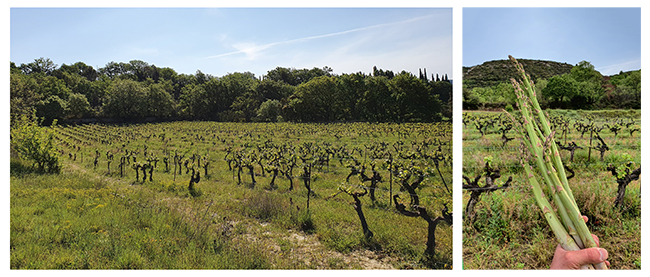
On the left are old vines of Merlot and Bourboulenc. Asparagus grows within the Bourboulenc vines. Photo by Julien Besson
In sum, the Domaine currently consists of ten varieties. The five red grape varieties are Grenache noire, Syrah, Cinsault, and Merlot (not AOP permissible) and, just recently, Counoise. The five white grape varieties are Grenache blanc, Bourboulenc, Clairette, Vermentino (Rolle), and Sauvignon blanc (not AOP permissible) .
The Luberon Appellation
Domaine de la Cavalière lies in the heart of the Luberon Appellation, in the most southeastern corner of the Rhône Valley wine region. The appellation, established in 1988, consists of somewhere around 3,000 hectares of vineyards, with around 55 privately-owned wineries but around 450 vineyards and 14 cooperative wineries. The appellation is tucked into the Luberon Natural Park. One of the most popular destinations in Provence and, yet, most people do not know anything about Luberon wine and many people who drink the wine, understandably, assume it is part of the Provence wine region.
Part of the confusion stems from the fact that, administratively, the Luberon is in Provence (that is, the administrative region of Provence-Alpes-Côte d’Azur or PACA) and its cultural identity has long been solidly tied to Provence. The most recent generation of visitors, introduced to the area by Peter Mayle’s A Year in Provence, published about the time the appellation was created, see the Luberon and Provence as synonymous. In general, the Luberon feels more like Provence than the Rhône Valley; nonetheless, the Luberon appellation falls into the Rhône Valley wine region.
I think it is safe to say that the vintners might experience a bit of an identity crisis. Squeezed in between Rhône ’s Ventoux and Provence’s Coteaux d’Aix-en-Provence appellations, the three areas, broadly speaking, share a Mediterranean climate and about the same number of sunny days. The soil – limestone, clay, and sand – is generally similar across the three appellations as are the dominant grape varieties. Over the years since achieving appellation status, the Luberon has gradually moved from predominantly red production to more rosé production, thus aligning itself much more with Provence, in terms of color, than the Rhône Valley (except, of course, Tavel).
A closer examination of the aforementioned characteristics suggests that the northern part of the Luberon, above the Luberon Massif, is more like the Rhône and the southern part is more like Provence. The Cahier des Charges (the book of rules that French winemakers must follow in order to be recognized by the appellation) specifies distinctly different regulations for each of the three appellations in order to achieve AOP status; too complicated to discuss here, but it might make more sense to divide the Luberon appellation into the northern and southern “terroir designations.”
Winemakers have long thought that AOP status (AOC, prior to 2012) was the pinnacle of achievement. It bolsters clout in the marketplace but, in the eyes of some winemakers, it does so at the cost of independence in both vineyard plantings and in determining the assemblage. In recent years, an increasing number of winemakers, especially in the south of France, have not sought a given wine’s AOP status (or relinquished it) in favor of the freedom offered by an IGP or Vin de France classification. They are motivated, in part, for purely creative reasons, but also to experiment with other grapes in order to be prepared for the possible impact of climate change. (This was a subject that surfaced in my conversations with winemakers at Wine Paris 2020.) In the Luberon, where there may be geographic differences that make the same appellation regulations in both the north and the south even more challenging (and even onerous) for everyone to follow, the motivation to go rogue may be even greater.
Arguably, this is a difficult decision for Luberon winemakers because the old image of cheap plonk from the Luberon is not entirely erased by the growing number of wines of exceptional quality from this appellation; thus consumers (who barely know Luberon AOP wines) might need a lot of education before buying a Vin de France from the Luberon. On the other hand, at a time when the number of privately owned wineries is growing and the dominance of cooperatives producing plonk is all but gone, this might be a good time to challenge the regulations specified by the Cahier des Charges. The winemaker would have to be confident in the quality of his or her wine and be in it for the long run.
“I think really interesting things are going to happen in the Luberon. It has gotten sort of lost – it’s not Provence and it’s not the Rhône Valley. All you have are the mountains. There is something that can happen here and it will be good,” opined Besson, who shares the view that separate appellations for the north and south Luberon may make more sense.
Domaine de la Cavalière Wine
The first vintage was harvested in 2017 and was full of challenges. In addition to having to cobble together a cellar to make the wine, it was a dry year and many vines were young. “With four tanks, a press machine, my parents, my uncle, and some friends – and some food to feed them – we started to pick the grapes,” Besson laughed. And, Bacchus be praised, it marked the inception of Besson’s winemaking.
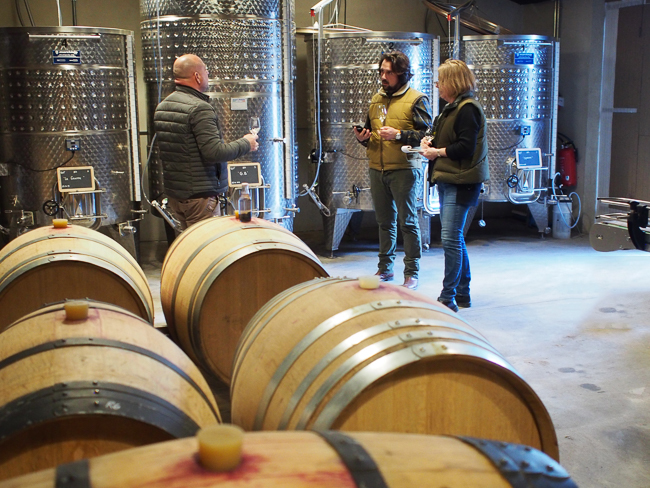
Tasting in the cellar of Domaine de la Cavalière. Pictured from left to right: Hervé Giustiniani, Julien Besson, and Susan Manfull. Photo by W.T. Manfull
Besson began the vinification process by consulting a lab to assess the acidity, the pH, and the sugar in the juice. “And the rest…euh, I make the wine like I cook. It is the same thing: taste the grape…okay, can I make a mix? Yeah, make a mix.”
For Besson, making the wine that best expresses the terroir – even at the sacrifice of consistency year after year — is his goal, regardless of appellation regulations. For Besson, a Vin de France label gives him the most flexibility and creative license. For him, making the wine as naturally as possible will yield the best results. This will take time, Besson explains, because you must first understand the terroir. “If you have the philosophy of the terroir, you can explain your philosophy in the bottle,” Besson said.
We had the pleasure of tasting quite a few wines during our visit, some alongside a charcuterie and cheese board (from Hervé’s shop, De la Cuisine au 20, in Lourmarin) and some from the barrel or tank. All were outstanding and, in some cases, on their way to being even better. All are made from hand-picked, organically grown grapes and vinified with native yeast, minimal intervention, very light filtration (of the rosé and the whites) and a tiny amount of sulfur added just before bottling. All are Vin de France wines.
Le Bouquet (2019) Rosé, exemplifying Besson’s philosophy described earlier – basically, letting the grapes determine the wine – is a very different cépage from the 2018 rosé and is vinified very differently. “I want to give my customers the real definition of the year,” Besson said. Although it is quite different from the earlier vintage, I felt Besson’s style is still apparent (although I am not sure he agreed with me). The 2018 rosé, which I first tasted at Le Saint Hubert, a restaurant in Saint-Saturnin-lès-Apt that specializes in natural wine, was an unusual blend of Syrah, Grenache, and Merlot. I loved it and wrote, in my notes, that I imagined strawberries served on slate with fresh mint. If possible, I’m even more smitten with this (highly) unusual blend of 70% Merlot, 15% Syrah, and 15% Grenache noir. “The Merlot was amazing,” Besson explained. “It was like elderberry flowers.” Around August, Besson decided, on the basis of tasting the grapes, what the blend would be.
The vinification process for the 2019 rosé was also different than that used in 2018. After de-stemming the berries, followed by two hours of cold-maceration (all grapes together), 60% of the juice goes into 1000-liter clay amphorae (made in France) for six months and the remaining 40% went into stainless-steel tanks for six months. Besson explained that the amphorae help to express the terroir and, in this case, led to some peppery spiciness and the tanks lead to more flavors of fruit, freshness, and acidity. The final product is extraordinary — beautiful balance and structure, layers of flavor, very dry, and incredibly refreshing. This is not a wine one takes to the pool; rather it is one you take to the table. one to pair with bouillabaisse. Besson sees couscous, tagines with dried fruits, curry, and Thai food.
The color, as you may have noted, is dark…and gorgeous. It might best be described as diaphanous candy apple. Besson told us that people who are accustomed to the very pale rosé of Provence think that it will be heavy and sweet. It is neither. Besson is unconcerned that Le Bouquet is not a cookie-cutter rosé as, by now, you undoubtedly understand that Besson is willing to take the time for consumers to get to know his wine.
This cuvée was just bottled in mid-April and is now available. About 2500 bottles were filled, 300 of which are already slated for China. We had better reserve some.
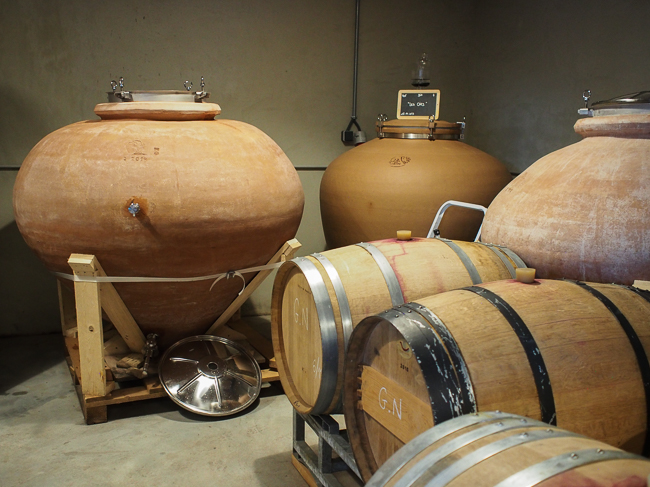
Amphorae used for production of Le Bouquet (2019) Rosé are on either side of a sandstone egg used for the production of Le Oies, an orange wine of 100% Grenache blanc. Photo by W.T. Manfull
After Tracteur (2018) was my introduction to Domaine de la Cavalière . Five months later, it seems more grounded. With the same freshness balanced by earthiness, the Grenache sang especially with a piece of Corsican coppa from the charcuterie. The 2019 After Tracteur — 100% old vine Grenache in stainless-steel tanks — will be bottled sometime this summer and ready for sale in January 2021.
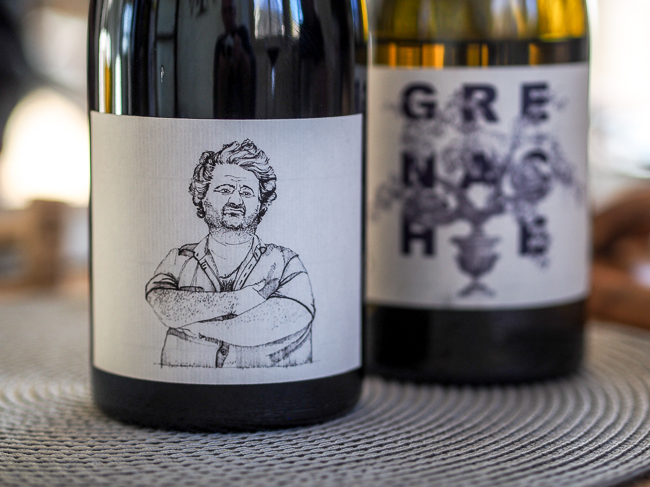
“After Tracteur” and “G.B.” bottles for our tasting. The beautiful, whimsical labels are the work of Juliette Ezavin, a French artist who now lives in London (and who is a friend of Besson). Photo by W.T. Manfull
G.B. (2019) is, as the initials suggest, 100% Grenache blanc, 50% of which spends time in the barrel while the other 50% is in stainless-steel tanks. This year’s Grenache blanc is very high in alcohol so Besson does not want to release it until the winter. “It is not the definition of summer,” Besson said. “I prefer to wait to release during the winter when you can serve it with, maybe, a guinea fowl, cooked with morel mushrooms with cream…something that I can drink a white wine with this acidity to make the balance with the cream and the food.” I tasted pears and then quince, the likes of which still linger in my mind. It will be bottled in the summer and released in the winter.
La Grappe (2019) is composed of 100% Bourboulenc, vinified in stainless-steel tanks. In contrast to the 2018 vintage which was 50% Bourboulenc blended with 50% Grenche blanc, the 2019 will be the single varietal Bourboulenc because, Besson explained, this year’s Grenache blanc would overpower the Bourboulenc. From the tank, the 2019 was already on its way to excellence – very dry, fresh, with distinct citrus, and even a little salinity. At 11.5% ABV, this white wine will be perfect for warm summer days.
“With natural wine, you must take your time because, if you take the time to make the wine, you can take the time to sell the wine and the guests will be happy to take the time to drink and to understand the philosophy,” Besson summed up. “This is the most important thing,” he added, repeating the the importance of keeping your philosophy in the bottle.
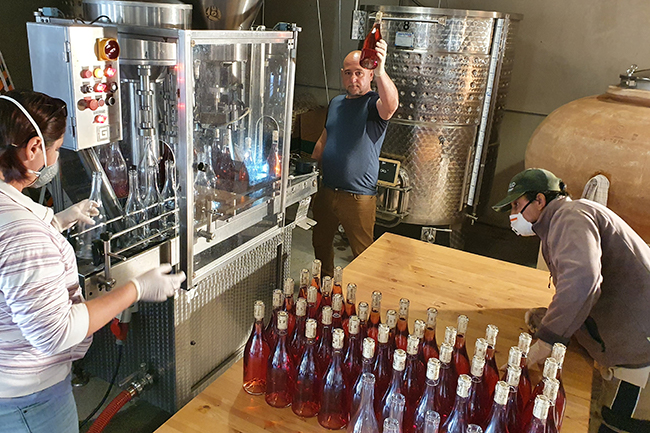
All hands on deck for the bottling of the current vintage of Le Bouquet Rosé. That’s Hervé Giustiniani is the center. Photo by Julien Besson
Besson continues to invite the same crew to pick the grapes and he still prepares a feast to cap off the harvest; I think conviviality will always play a center role in this project. The number of vines and grape varieties continues to grow. They are currently preparing the ground for future plantings. As I mentioned above, since our visit, Besson has planted Counoise (860 plants) in a small area of the property. Other grape varieties are under consideration. One such grape is Caladoc, a drought-resistant red skinned grape that is a cross between Grenache and Malbec. Grown primarily in the South of France, it is not permitted in any AOP wine (but, that may soon change). There will be a greater proportion of white varieties in the future (comprising as much as 70% of the vineyard) as you may recall that Besson believes white grapes will thrive in this part of the Luberon.
Besson’s portfolio is growing, too. I mentioned above that it changes depending on the nature of the vintage; but, currently, in addition to the cuvées I described above, there are four other wines in the cellar of the domaine: three red wines and an orange wine. Details on these wines to come later as they will not be released before 2021.
Besson ages his wines in the domain so that they are ready for consumption when they are purchased. He assumes they will be enjoyed soon after purchase. If not consumed right away, it is incumbent on the consumer to store the wine properly because, being natural wines, they lack the sulfur necessary to preserve the wine for a long period, especially without proper storage.
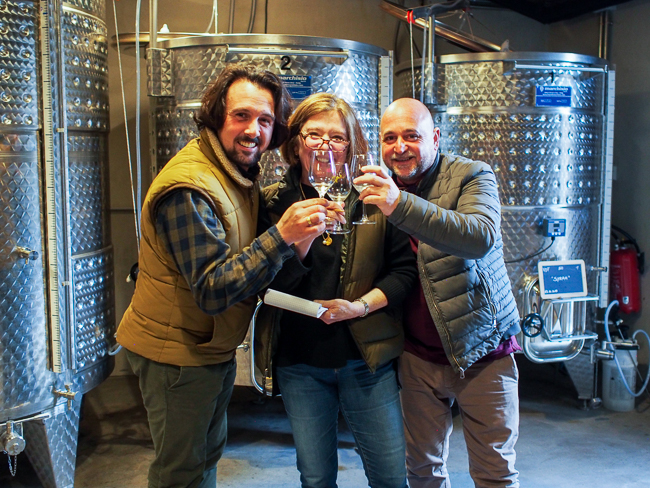
(Pre-social-distancing) toast to natural wine. Pictured left to right: Julien Besson, Susan Manfull, and Hervé Giustiniani. Photo by W.T. Manfull
My greatest challenge is to make natural wines that can age for 20 years. “I want to change the way people think of natural wine…I want to show everybody that it is possible,” Besson said.
Conforming to the appellation, Besson said, is not “a good way to be an artist.” It may take longer to market the wine without the benefit of the appellation, Besson agrees, but ultimately, it is the savoir faire of the winemaker that the consumer will buy — they will “drink a winemaker.”
There is no address and, at this time, people don’t know where Domaine de la Cavalière is, as Besson and I discussed: “It’s a secret place.” But, they will soon learn where the winemaker with the natural wine works.”

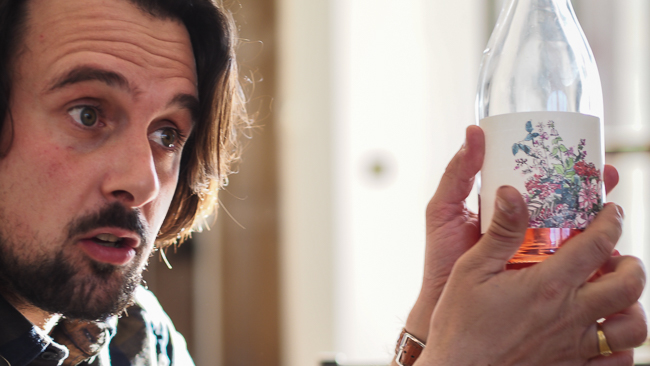
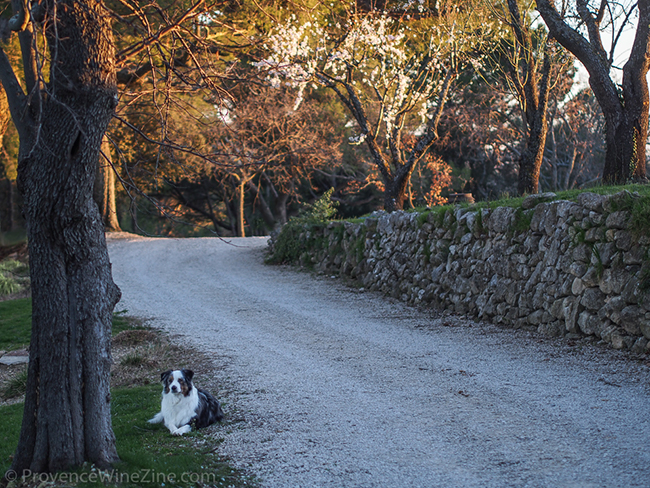
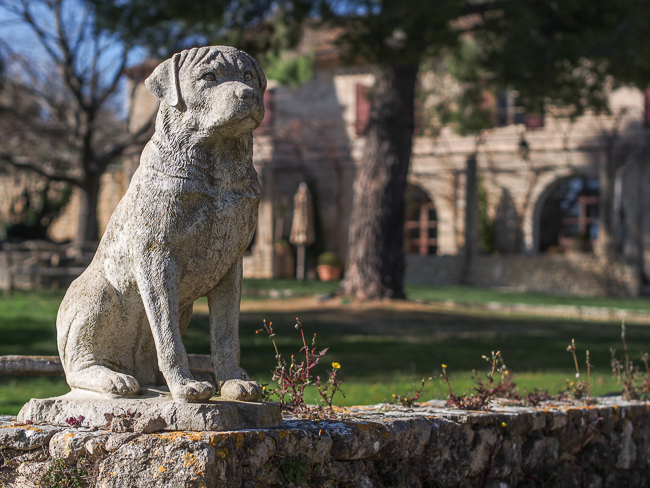
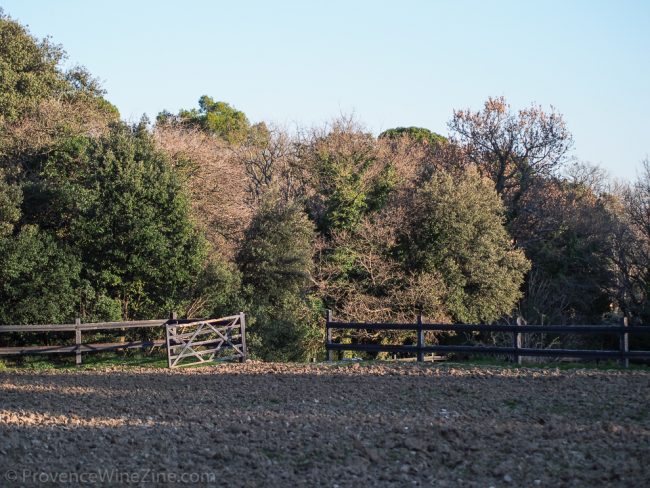
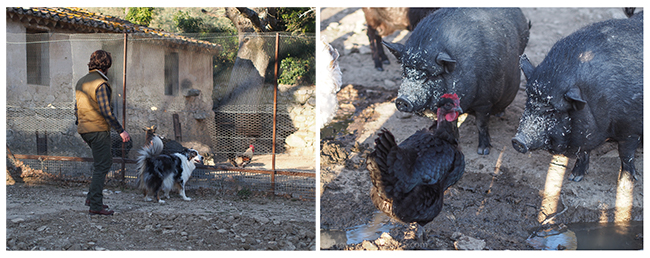
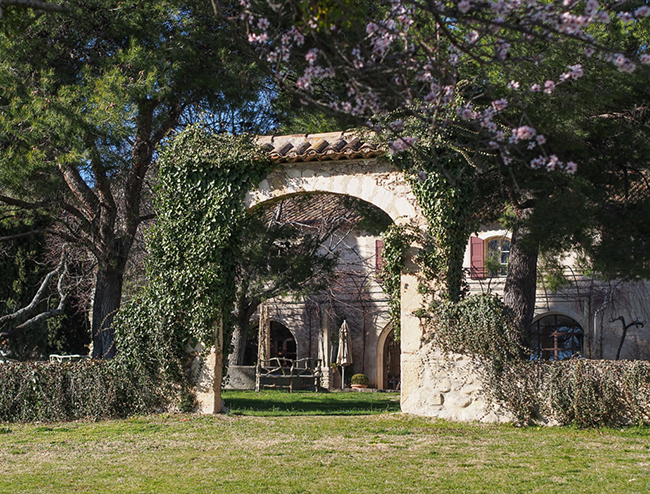
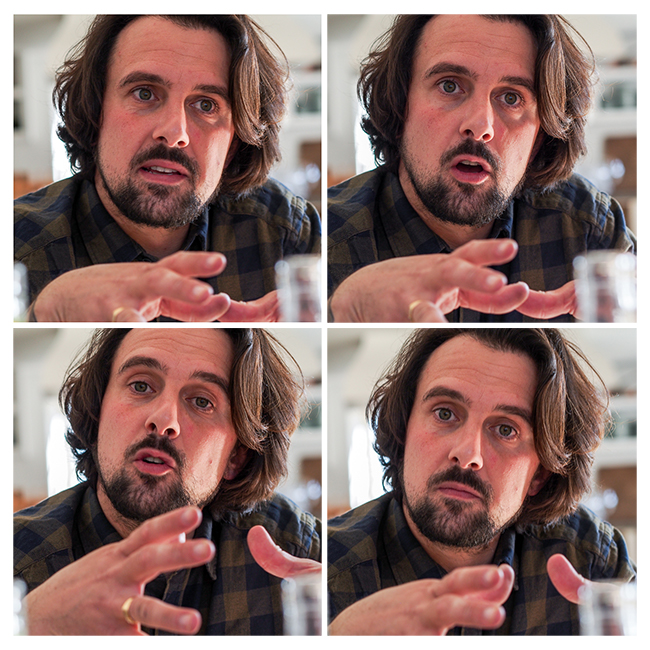
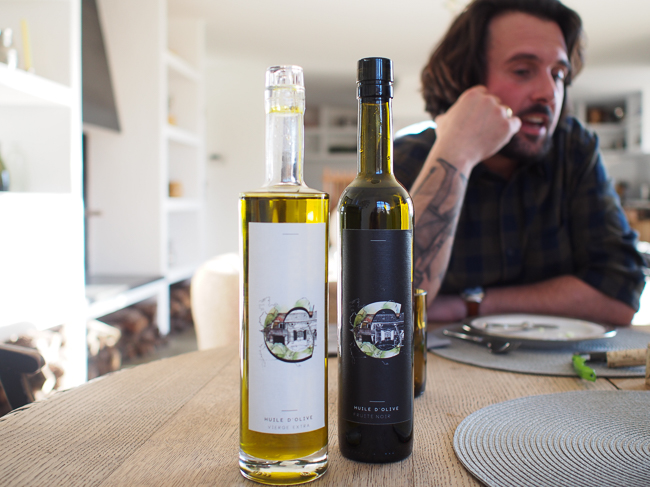
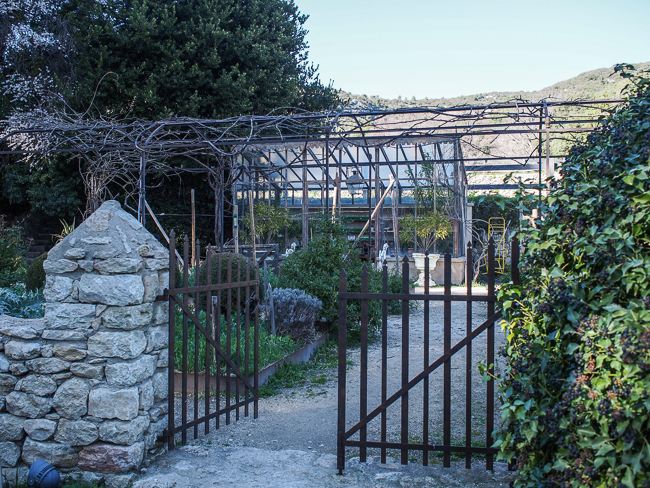
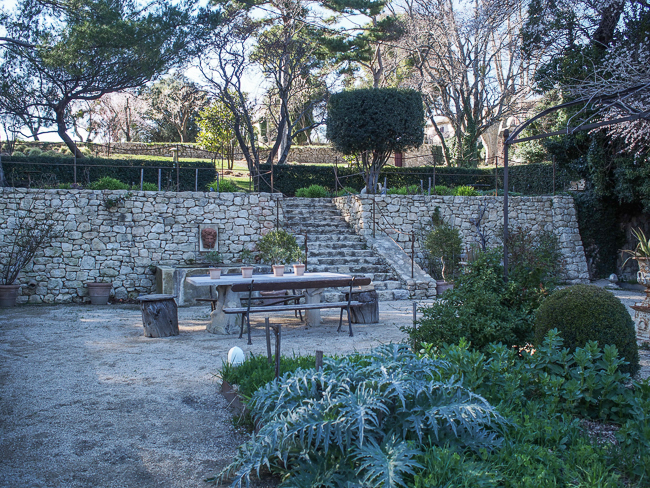
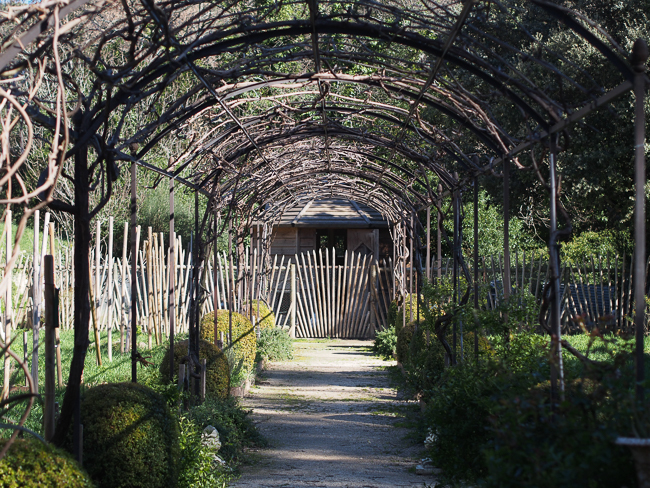
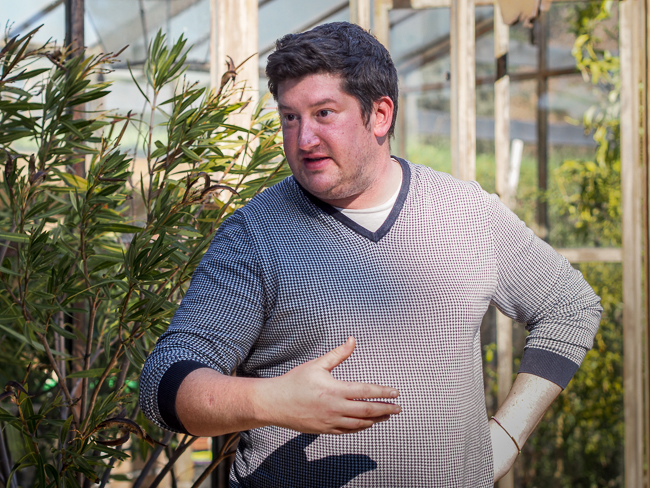
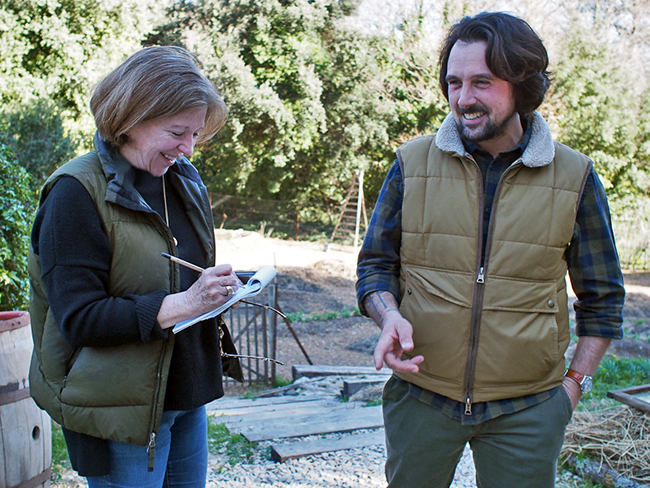
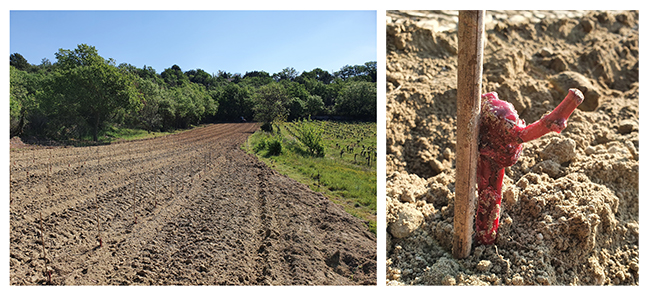
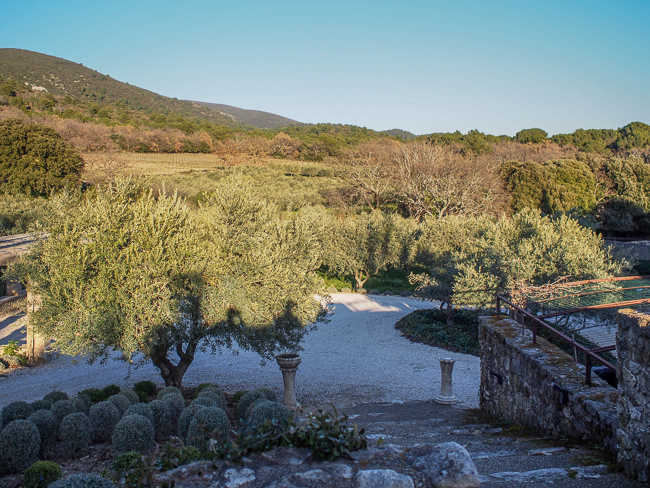
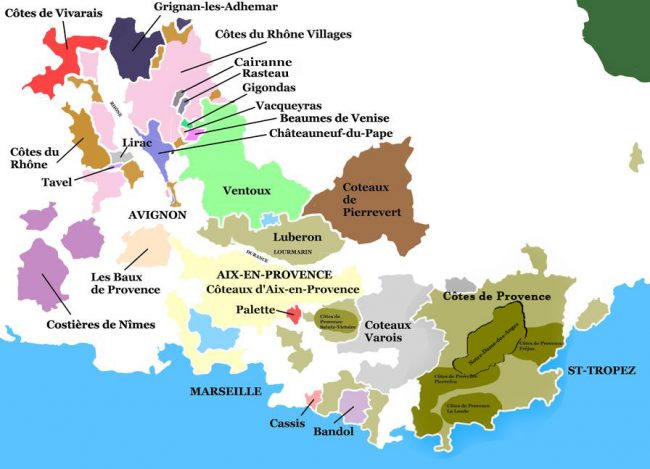
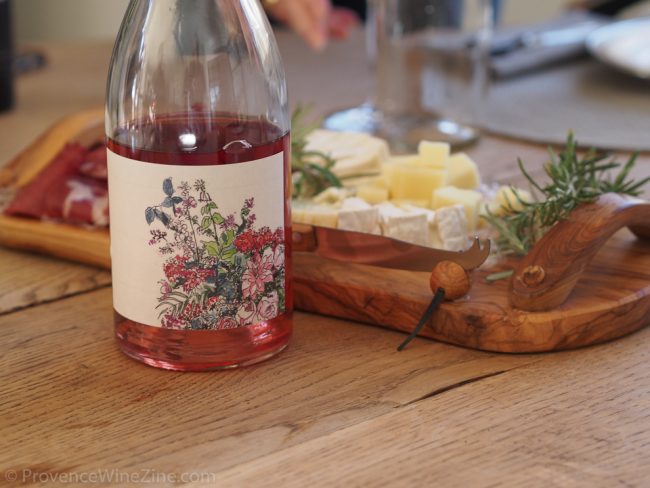
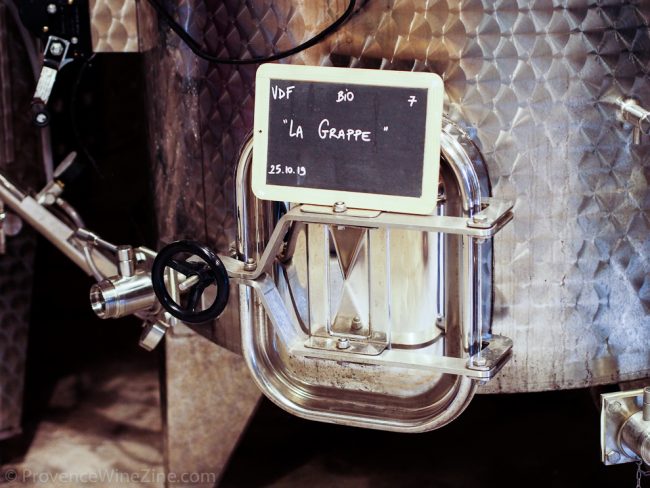
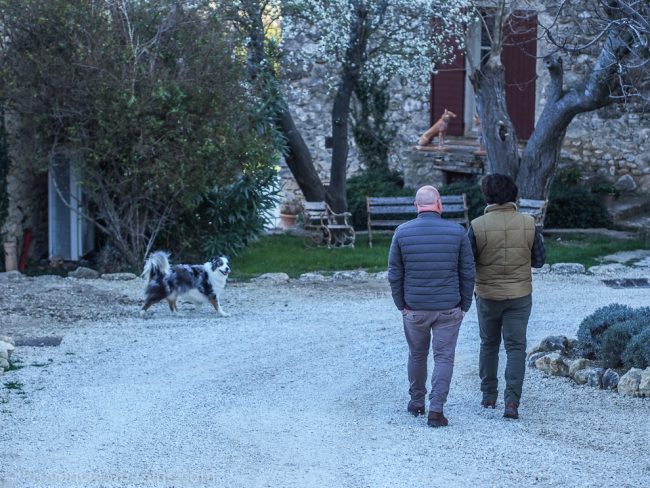
A great article, Susan, congratulations!
Thank you, Franco, for such a nice endorsement. It was lots of fun to “do the research” and to write about this talented winemaker!
Dear Susan,
This has been a wonderful story, and the mystery that you and Towny have been visiting and living in Lourmarin for so many years, that you never knew that this vineyard existed, and the fact that it has no address, that made me laugh, Towny’s images really show that Julien and Herve have found what so many people are looking for , their own utopia.
Love from Paul
Hi Paul, Thanks for that nice feedback! This property would be a perfect backdrop for a film about a utopia but, of course, the world in which a winemaker works is far from perfect…what with hail, and pests, and wildlife to mention just a few challenges. It is fun to think about, especially now! Love right back to you!
Susan, your article is really astonishing. You’ve captured the essence of the place and the people and then done a very intelligent and complete description of the wine and the process of making it. kudos to you but also to Besson et al.
Good job,
Lin
Hi Lin, So nice to see your name pop up. You are not so far away that, when Coronavirus worries have subsided, you can head over to Lourmarin and pick up a bottle of Besson’s wine. Thank you for the very nice feedback on the article and for the kudos to Julien and his team. Stay well!
Très bel article m’a été donné de lire. Il retranscrit très bien je que j’ai compris de Julien au travers des valeurs insufflées par ses parents. Bonne continuation à Julien dans sa démarche.
Merci, Didier, pour vos aimables commentaires sur l’article. Ce fut un plaisir d’interviewer Julien et de découvrir le bon travail que lui (et son équipe) accomplit au domaine. J’ai hâte de suivre ses progrès et d’apprécier ses vins.
What a delightful post, Susan! I can hardly wait to return to Lourmarin where I hope to have the good fortune to try some of these wines. I was thinking of you Sunday evening when I had to select a bottle of wine to accompany a special spring lamb dinner. I wondered which bottle in my slim collection you might chose. I discovered a bottle from Domaine de L’Ocre Rouge which I believe is about 150 km east of Lourmarin-although I could be wrong about that. It was a 2015 biodynamic red blend grown at the estate, De Natura Vini. My research said it would pair well with lamb. The wine was rich and intense while being smooth and delicious with a nice finish. We had a lovely respite in the midst of this horrific pandemic, and we toasted—”a votre santé bonheur” which I extend to you and Towny.
Hi Heidi, You must try Julian’s wines the next time you are in Lourmarin! It sounds like you are making the most of this period — cooking good food and pairing it with good wine!I can’t wait until we can do that together! Et à votre santé, mes chers Dennis et Heidi!
Comme c’est divine!! What a fabulous story and photographs by you and Towny. Indeed, it is like a fairy tale, written and illustrated so beautifully. Thank you for allowing me to daydream…..Audrey
Hi Audrey, This story does inspire day dreaming doesn’t it? Towny’s photo’s bring the words alive! We will elaborate when we see you…sometime soon!
MERCI Beaucoup Susan et Towny d’être venus avec Hervé afin de découvrir tout l’environnement de La Cavalière et ma Philosophie de travail. Votre venue m’a fait énormément plaisir car vous êtes des passionnés et de très belles personnes avec un coeur généreux…. c’est pour cela que nous avons passé presque 5h à échanger nos questions / réponses. Encore MERCI pour votre si joli article, les photos de Towny qui illustrent si bien l’écriture de Susan et la Magie Mystérieuse de ce lieu. J’ai très rarement lu un article aussi complet et détaillé… à très bientôt au Domaine pour un déjeuner dans le potager avec nos tomates, notre basilic, notre huile d’olive, notre Rosé… et vos Sourires.
Julien
Ah, c’était un après-midi magique … c’est toujours gratifiant d’écrire une histoire comme la vôtre et de l’équipe du Domaine de la Cavalière. Le plus grand défi était de trouver les bons mots pour raconter cette merveilleuse histoire. Les photos de Towny ont donné à l’histoire une texture et une richesse. Nous te remercions de l’invitation et, bien sûr, remercions chaleureusement notre cher ami commun Hervé pour sa présentation à toi et à ton vin. Nous sommes impatients de revenir et de nous retrouver dans le potager pour ces tomates fraîches et basilic avec votre fabuleuse huile d’olive et, bien sûr, ton vin.
This mystery has moved to the top of my list to solve. I’ve been distracted, admittedly. The first time was a tease and I put it down until I could finish it. Once I did, I immediately reread it because the third time I wanted to meander, breathe deeply, soak in the aromatic fragrances, be drawn into the textures and touch the elements as I lingered long in the potager, held the terroir in my hand to feel its warmth and see the color more closely. At the end I wanted to travel back in time to be able to hug everyone responsible for this domaine, it’s fabulous team and those who so highly recognize the value of building a future in such a creative sustainable trajectory tightly, with gratitude, joining in the beauty of this magical secret haven with absolutely no inkling of what was to come so soon after. With our wandering ceased, this was the perfect read and visual alternative to quarantine. Thank you Susan for an exquisite article and Towny for the fabulous captures of this paradise. And, of course, for sharing After Tracteur and Lé Bouquet In Lourmarin. As a long time close friend of an award winning wine writer, I probably should not admit that I would have chosen that wine based merely on the artistry of the label, no recommendation required. Such a fine escape this has been. Thank you once again for reminding me of the magic that is held in wonders of the south of France ?? ?
Hi Patti, We will take a walk to Domaine de la Cavalière the next time we are in Lourmarin together so you can feel the magic. Thanks for the kind feedback and lovely thoughts about that area of the world.
p.s. the label I referred to at the end is Lé Tracteur
Actually, you were right the first time….the cuvée is “After Tracteur.” I neglected to ask Julien why he used the English word. By the way, you tasted this wine!
Such an intriguing and interesting story Susan! The idea of a vineyard with no address is fabulously captivating. I love “discreet”. Cant wait to get to Lourmarin (whenever there might be flights again from Australia to France) so that I can appreciate the full experience by finding this unidentified vineyard as well. Looking forward to it! Cheers
Hi Neil, After you had to abruptly curtail your trip and return home (due to Covid), I suspect you are camping at the bit to resume your trip, including Lourmarin! As a person well acquainted with the Rhone Valley, I will look forward to hearing your thoughts about the Luberon AOC. Thanks for the nice feedback.
What a great article. Susan. I would so love to go there…. to taste the wines, see the vineyards and wander in his potager. I love the huge artichoke plant, and the handful of asparagus that was growing amongst the vines. What a labor of love this is for him, his fiancée and the others. By the way, I love the photo of you and Julien together in your matching olive-colored vests!
Well, you will just have to return to Lourmarin…and don’t wait until the next round number! You and Mark would love a stroll through the potager and, of course, the wine!
Chères Vous,
Ma découverte de l’incroyable travail de Julien est à présent le plus beau cadeau que j’ai pu vous faire. Vous sublimez le travail des vignerons qui m’est si important… nous partageons un plaisir commun et qui ne peut que comme le vin prendre du beau et bon goût avec le temps.
Il y aura toujours dans nos verres une pensée émue et une grande envie de dire à nouveau SANTÉ ou « chers ».
Mon secret est à présent le vôtre.
À bientôt vous revoir.
Amitiés
Herve
Cher Hervé, le vin et la nourriture peuvent rapprocher les gens, mais on a de la chance quand il y’a quelque chose de spécial que les maintient ensemble. Je suis reconnaissant d’être ton ami et maintenant d’être un ami de tes amis. J’ai hâte de vivre plus de moments oenologiques ensemble. Un toast à Julien et ses vins.
Susan, we are a small producer in Russian River Valley ( in fact next door to a farm by the same owners). How could we arrange to visit DOMAINE DE LA CAVALIÈRE? Thanks so much!